About
The proprietor of Paekariki Press is Matthew Arthur Mckenzie, a native of New Zealand. [2] The company makes use of a variety of different printing tools that date from between the nineteenth and early-twentieth century. The books are typeset using the Press's own Monotype Composition Caster, printed on a Heidelberg KS Cylinder and bound by hand. So far, all their publications have been of poetry. [3] [4]
They have published over 40 titles including works by several internationally prominent poets, including Ivy Alvarez, Alan Loney and George Szirtes. [5] In at least one instance, the company has raised funds for the publication of a book using the crowdfunding platform Kickstarter. [6]
In addition to publishing handmade books, the company also offers letterpress workshops and other similar activities to the public. [7]

Letterpress printing is a technique of relief printing. Using a printing press, the process allows many copies to be produced by repeated direct impression of an inked, raised surface against sheets or a continuous roll of paper. A worker composes and locks movable type into the "bed" or "chase" of a press, inks it, and presses paper against it to transfer the ink from the type, which creates an impression on the paper.

American Type Founders (ATF) was a business trust created in 1892 by the merger of 23 type foundries, representing about 85% of all type manufactured in the United States. The new company, consisting of a consolidation of firms from throughout the United States, was incorporated in New Jersey.

Monotype Imaging Holdings Inc., founded as Lanston Monotype Machine Company in 1887 in Philadelphia by Tolbert Lanston, is an American company that specializes in digital typesetting and typeface design for use with consumer electronics devices. Incorporated in Delaware and headquartered in Woburn, Massachusetts, the company has been responsible for many developments in printing technology—in particular the Monotype machine, which was a fully mechanical hotmetal typesetter, that produced texts automatically, all single type. Monotype was involved in the design and production of many typefaces in the 20th century. Monotype developed many of the most widely used typeface designs, including Times New Roman, Gill Sans, Arial, Bembo and Albertus.

In printing and typography, hot metal typesetting is a technology for typesetting text in letterpress printing. This method injects molten type metal into a mold that has the shape of one or more glyphs. The resulting sorts or slugs are later used to press ink onto paper. Normally the typecasting machine would be controlled by a keyboard or by a paper tape.
A platen is a flat platform with a variety of roles in printing or manufacturing. It can be a flat metal plate pressed against a medium to cause an impression in letterpress printing. Platen may also refer to a typewriter roller which friction-feeds paper into position below the typebars or print head, it can refer to the glass surface of a copier, or it can refer to the rotating disk used to polish semiconductor wafers.
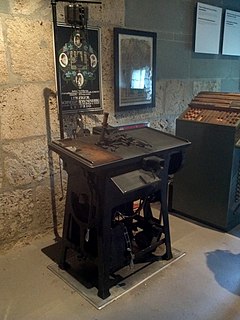
A Ludlow Typograph is a hot metal typesetting system used in letterpress printing. The device casts bars, or slugs of type, out of type metal primarily consisting of lead. These slugs are used for the actual printing, and then are melted down and recycled on the spot. It was used to print large-type material such as newspaper headlines or posters.

The Type Archive is a collection of artefacts representing the legacy of type founding in England, whose famous type foundries and composing systems supplied the world with type in over 300 languages. The Archive was founded in 1992 by Susan Shaw in Stockwell, South London.

Robert Smail's Printing Works is a fully functional Victorian era letterpress printing works in the small Scottish Borders town of Innerleithen, now preserved by The National Trust for Scotland as an Industrial Heritage museum showing visitors the operation of a local printer around 1900 while still carrying out orders for printing and stationery.

Heidelberger Druckmaschinen AG is a German precision mechanical engineering company with registered offices in Heidelberg (Baden-Württemberg) and headquarters in Wiesloch/Walldorf (Baden-Württemberg). The company offers products and services along the entire process and value chain for printing products and is the largest global manufacturer of offset printing presses. Sheet-fed offset printing is used predominantly for high-quality, multi-colour products, such as catalogues, calendars, posters, and labels. Heidelberg produces equipment for prepress, press and postpress.

The Grabhorn Institute is a nonprofit organization formed in October 2000 for the purpose of preserving and continuing the operation of one of the last integrated facilities for typefounding, letterpress printing, and bookbinding in the fine press tradition, as a living museum and educational and cultural center. It is named in honor of the brothers Edwin and Robert Grabhorn, who established the Grabhorn Press in San Francisco in 1920. The press was "one of the foremost producers of finely printed books in twentieth-century America." The Grabhorn Press Building is listed on the National Register of Historic Places in San Francisco, California.

A jobbing press, job press, or jobber is a variety of printing press used in letterpress printing.

Chandler & Price was founded in 1881 in Cleveland, Ohio, by Harrison T. Chandler and William H. Price. They manufactured machinery for printers including a series of hand-fed platen jobbing presses, as well as an automatic feeder for these presses, paper cutters, book presses, and assorted equipment. Despite dominating the industry in the 1930s, by the 1950s the offset printing industry had eclipsed the world of movable type printing, and only Chandler & Price and Brandtjen and Kluge continued to make open platen (Gordon) presses. Chandler & Price ceased production of presses in 1964.
The Gregynog Press, also known as Gwasg Gregynog, is a printing press and charity located at Gregynog Hall near Newtown in Powys, Wales.
The Rampant Lions Press was a fine letterpress printing firm in Britain, operating from 1924 to 2008. The firm was founded by Will Carter, publishing its first book in 1936, and was continued by his son, Sebastian Carter, from 1966.
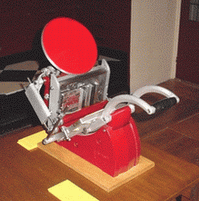
Adana Printing Machines were manufactured from 1922 to 1999 in Twickenham, England. Although most of the printing presses produced by Adana were aimed at hobby printers, they were frequently put to commercial use. Adanas are still to be found throughout the world in the hands of colleges, enthusiasts and professional printers. Caslon Limited manufactured machines after a takeover of the company in 1987.

Imprint is a serif typeface created by Monotype, commonly used for body text. Originally called Imprint Old Face, it is a sturdy, amiable design with a large x-height, Caslon-like but with more regularity in its letterforms. It was commissioned by the London publishers of The Imprint, a short-lived printing trade periodical published during 1913.
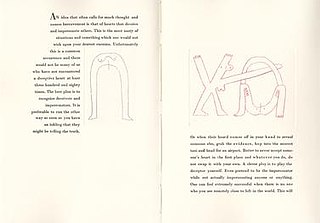
Finlay Press is the name of an independent private press founded by Ingeborg Hansen and Phil Day (artist). It began production in Goulburn, NSW, Australia in 1997. In 2001 the press moved to Braidwood, New South Wales, Australia, where it printed its final publication in 2009.
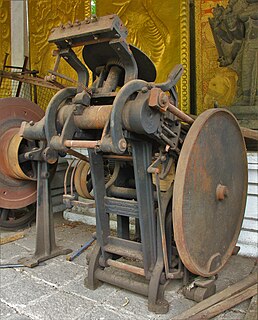
Harrild & Sons Limited is a defunct British manufacturer of printing machinery and supplies. The company was founded in 1809 by Robert Harrild at Norwich Street, London, and closed down in 1949. The company helped to establish the use in London of composition rollers instead of ink balls to ink the printing plates.
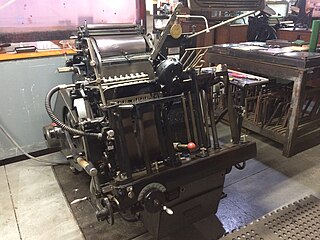
The Original Heidelberg Platen Press was a letterpress printing press manufactured by the Heidelberger Druckmaschinen company in Germany. It was often referred to as the Heidelberg Windmill, after the shape and movement of its paper feed system. When introduced, it was also called the "Super Heidelberg" or the "Super Speed".
The Penrith Museum of Printing is a museum in Penrith, New South Wales, Australia with a focus on Australian letterpress printing equipment and techniques.















